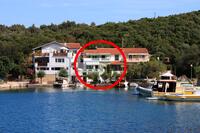UNESCO in Croatia
UNESCO World Heritage List includes as many as 18 Croatian properties, identified as phenomena of great importance to the common heritage of humanity. As many as 7 of them are historic-cultural and natural monuments, and 11 are intangible cultural values which include customs, rituals, festivals, artistic performances, and knowledge, skills and artistry connected with traditional crafts.
Croatia is listed at the top of the UNESCO World Heritage List so be sure not to miss some of these treasures while on your vacation in the Adriatic!
Tangible Heritage
- Diocletian's Palace and medieval Split – turned into a Christian cathedral, mausoleum of the Roman emperor Diocletian makes a harmonious unity with medieval buildings within the complex of this ancient summer palace.
- The Cathedral of St James in Šibenik – built entirely from stone, with no mortar, Šibenik Cathedral is a great example of the 15th and 16th century architecture. Built over a period of 105 years today the Cathedral is considered a unique example of Renaissance architecture due to its decoration of 71 sculptured human faces situated on the exterior apse.
- Plitvice Lakes National Park – with its 16 waterfalls, this most famous karst phenomenon in Croatia is considered to be one of the most beautiful natural monuments in all of Europe.
-
Historic City of Trogir - City of Trogir has preserved elements of its medieval fortified city structure known for its characteristic squares and street plan, sacral and profane buildings all of which ensured Trogir an entry on the UNESCO World Heritage List.
-
Episcopal Complex of the Euphrasian Basilica in the Historic Centre of Poreč – this early-Christian cathedral is one of the finest examples of early Byzantine art. Named after bishop Euphrasius the basilica is famous for its golden mosaics.
- Old City of Dubrovnik – within this perfectly preserved complex of city walls you'll find Gothic, Renaissance and Baroque churches, monasteries, palaces and fountains.
-
Stari Grad Plain – this largest fertile plain on all of Adriatic islands was divided into geometrical parcels of vineyards and olive orchards in 384 BC and remained practically intact to this day.
Intangible Heritage
-
Procession "Za križen" (Following the Cross) on the island of Hvar – this lent custom has been practiced by people of Hvar for 500 years now. In the night of Maundy Thursday each of six villages in Hvar Island sends a procession which follows its cross-bearer, says prayers and sings traditional religious songs.
-
Spring procession of Ljelje/Queens from Gorjani – procession of Gorjani village queens is an Eastern custom practiced on Whitsunday. Group of ten girls 'queens' with white garlands on their heads and group of ten girls 'kings' with sabers and men hats decorated with flowers process together from house to house and perform a ritual where kings dance with sabers and queens sing.
- Two-part singing and playing in the Istrian scale – this style of singing has a very distinctive sound achieved by vigorous, partly nasal singing. In layman's terms it might even be described as sounding a bit ''messy'' concerning tone purity. The singing involves improvisation in both vocal parts but always ends with two performers singing in unison or an octave apart.
-
Lacemaking in Croatia – tradition of lacemaking in Croatia is connected with smaller villages and rural women who created lace as a source of additional income. Women in Hrvatsko Zagorje and Lepoglava create bobbin lace, on the island of Pag needle-point lace and on the island of Hvar lace is created of thin aloa threads.
- Festivity of St Blaise, the patron of Dubrovnik – the custom has been celebrated for 10 centuries now. It is based on the legend of St Blaise appearing in a vision to warn people of Dubrovnik of an impeding attack by the Venetians.
- Annual carnival bell ringers' pageant from the Kastac area – groups of men wearing masks, sheepskin throws, bells (hence bell ringers) and colorful decorations on their heads march through the villages during the carnival period. They move rhythmically, ringing the bells attached around their waists.
-
Traditional manufacturing of children's wooden toys in Hrvatsko Zagorje – men in family make unique, hand-made toys using soft willow, lime, beech and maple wood, and then women paint them, mostly in red, yellow and blue color, and apply different floral and geometrical patterns.
-
Sinjska alka, a knights' tournament in Sinj – it's a chivalric tournament in which knights at full gallop aim their lances at alka – a small iron ring hanging on a rope. The most prized hit is the one to the center of the ring.
-
Gingerbread craft from Northern Croatia – the tradition of gingerbread making resulted in gingerbread craft and a distinctive Croatian souvenir – gingerbread heart (licitarsko srce). They are made from flour, sugar and various spices and moulded – most usually in the form of heart – and then decorated with colors, small mirrors, messages or verses.
-
Bećarac singing and playing from Eastern Croatia – in the attempt to ''out-sing'' one another, two leading singers create and combine decasyllabic verses which are happy and perky in their nature. All the while they are accompanied by a group of singers and tambura bands. Bećarac is typical for the area of Slavonia, Baranja and Srijem.
-
Nijemo kolo, silent circle dance of the Dalmatian hinterland – this is the only dance of the Dalmatian Hinterland which involves circle of dancers that ''breaks'' into couples who continue to move around freely or in a circle. It's performed without music, hence the name.
-
Klapa multipart singing of Dalmatia, southern Croatia – This multipart a capella singing is traditionally performed all along the Croatian Adriatic. Originally klapa was made of 5 to 8 singers, however due to its popularity it has transformed and today the term encompasses both traditional and popular melodies, smaller and greater number of singers, male, female and mix groups.










